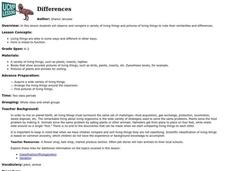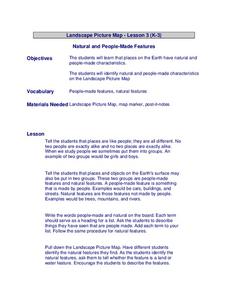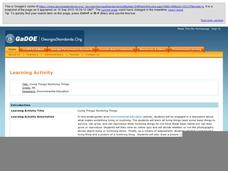Teaching Tolerance
Using Photographs to Teach Social Justice | Affirming Our Commonalities and Differences
Photos can challenge stereotypes. To gain an understanding of the big picture, groups examine a series of photographs and analyze how a photographer's choices can shape a viewer's reaction to an image. For the first set of photographs,...
Curated OER
Alike and Different
In this early childhood alike and different worksheet, students examine the 5 groups of objects and identify the group that the first picture belongs to.
Curated OER
Library Lesson Plan
Explain the differences between fiction and non-fiction and the characteristics of a biography. Learners analyze three pieces of literature on the same topic to determine which is fiction and which is non-fiction. In the end, relate the...
Curated OER
We're Alike, We're Different!
Students compare a variety of people counters to determine how they're alike and different and then sort, classify and write about how they sort and classify people counters.
Curated OER
Alike or Different?
In this alike or different visual thinking worksheet, students find the picture in each of 3 rows that is different from the other two. Students draw a picture to match the different one. Students then complete 3 more problems; this time...
Curated OER
Which one is Different?
In this alike and different worksheet, students view and study 9 pictures of Dr. Seuss. Students determine which one is different from the others. Students draw a circle around the one that is different.
Curated OER
Differences
Pupils observe and compare a variety of living things and pictures of living things to note their similarities and differences.
Arkansas Government
Creative Adventures with Literature - Whoever You Are
Celebrate our similarities and differences through multiple readings of Whoever you Are by Mem Fox. Readings are accompanied by a grand discussion, charts, creative art, dramatic, and music play to reinforce the uniqueness that is...
Curated OER
Landscape Picture Map
Students discuss differences between man made and natural features on the Earth's surface. In this natural and man made features lesson, learners brainstorm a list of features and categorize them on the board. Students study a landscape...
Curated OER
We Are All Different in Many Ways!
Students draw a picture with only one color crayon. As a class, they discuss how the world would be different if there were only one color crayon to use. After being read a book, they discuss how each person is important even though...
Curated OER
We Are All Different in Many Ways!
Pupils discuss differences such as skin color, eye color, hair color, emotions, families, etc., to reinforce that it is okay to be different.
Curated OER
Landscape Picture Map - Lesson 8 (K-3)
Students explore the functions of landscape picture maps. In this geography skills lesson, students examine a landscape picture map and identify buildings on the map where people are employed. Students also participate in a discussion...
Curated OER
Homographs
In this recognizing homographs worksheet, students observe boxes containing picture clues, two incomplete sentences, and two choices of answers. Students fill in the 9 blanks with the correct homograph choices.
Curated OER
Getting to Know You
Students converse with each other while playing a game in order to discover things that are alike and things that are different about themselves. The students gather data about themselves, organize and display data on the graph, and...
Curated OER
Landscape Picture Map: Natural and People Made Features
Students explore the places and objects that make up the Earth's surface. In this natural and people made features lesson, students identify things they've seen that are people made and those that are natural to the environment. ...
Illustrative Mathematics
Running Around a Track I
The accuracy required by the design and measurement of an Olympic running track will surprise track stars and couch potatoes alike. Given a short introduction, the class then scaffolds into a detailed analysis of the exact nature of the...
Houghton Mifflin Harcourt
Unit 1 Math Vocabulary Cards (Grade K)
A set of 24 math vocabulary cards enhances any math lesson for beginning readers. Each sheet contains two vocabulary words. The top card has the vocabulary word printed in bold text. The bottom card has a picture...
Curated OER
Digital Plants...Alike and Different!
Third graders. in groups, take pictures of plants and turn them into a learning game.
Curated OER
Author Study: Laura Ingalls Wilder
Students read novel, Little House in the Big Woods, explore web sites and other resources devoted to author, Laura Ingalls Wilder, complete Venn Diagram showing ways they and author are alike and different, and create diorama, read...
Curated OER
Comparing and Contrasting Literature Using Venn Diagrams
First graders create a venn diagram with two folktales. In this folktale lesson, 1st graders read Cinderella and Mufaro's Beautiful Daughters by John Steptoe. They find the similarities and differences and chart these on a venn...
Curated OER
Where People Live- Neighborhoods
Students use a map. In this neighborhood activity, students describe a neighborhood, emphasizing the common characteristics between all neighborhoods. Students locate a neighborhood on a landscape picture map and discuss.
Curated OER
Language Arts: Word Recognition and Mental Images
Students read short stories containing Dolch sight words and describe the scenes and answer comprehension questions. After relating the stories to their own experiences or observations, they draw pictures illustrating a scene from the...
Georgia Department of Education
Living Things/ Nonliving Things
How can you tell if something is living or nonliving? Introduce a set of criteria which can be used to determine which things are alive and which are not. The class discusses the basic needs of all living organisms, checks out an...
Curated OER
Landscape Picture Map
Students identify a neighborhood on a Landscape Picture Map. In this geography lesson, students discuss the characteristics of their neighborhood and identify their neighborhood on a Landscape Picture Map. Students use post-it notes to...

























